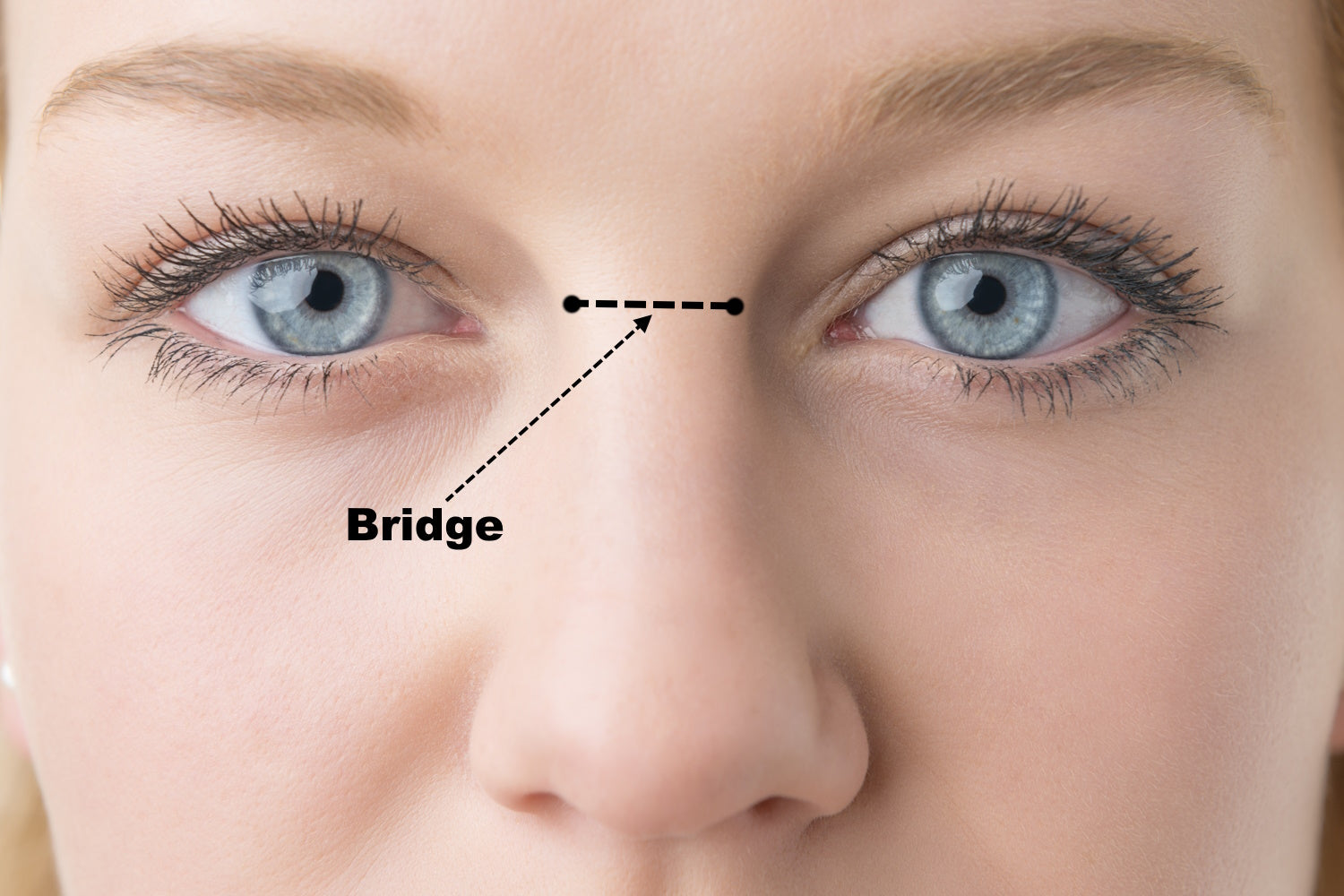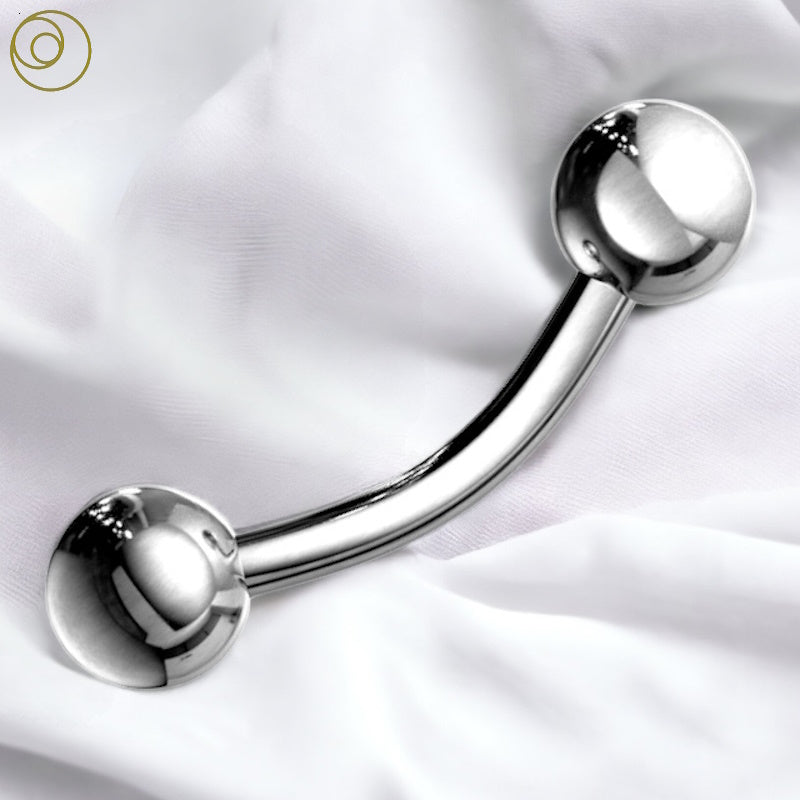
Bridge Piercing: A Witty Guide To The Bridge
Share
Bridge Piercing Article Quick Reference:
History | Myths | Complications | Pain | Cost | Procedure | Healing | Aftercare | Jewelry | Celebrities
Related Articles & Jewelry:
Bridge Jewelry | Curved Barbells | Straight Barbells
The bridge piercing, as its name suggests, boldly spans the bridge of the nose, transforming it into a canvas for nose-related adventures. Positioned horizontally, this piercing adds a touch of edgy flair to your facial features, making a stylish statement that bridges the gap between fashion and self-expression.
If you would like a visual along with the location description above, see the diagram below.

BRIDGE PIERCING HISTORY
In ancient times, various cultures explored the art of nose adornment. From the ornate nose rings of Indian goddesses to the intricate septum piercings of African tribes, nose fashion had already laid the groundwork for the bridge piercing to strut its stuff. While the bridge nose piercing may not have been as prevalent in ancient history, our ancestors certainly knew how to rock the nose bling.
Many piercing enthusiats know the brdige piercing also by the name of the Erl piercing. The term "Erl" in reference to a bridge piercing comes from the first known person to wear this type of piercing, Erl van Aken. Erl was a prominent figure in the body modification community, and this piercing style gained popularity in part due to his influence.
The bridge piercing emerged as a rebellious fashion statement, challenging societal norms and pushing the boundaries of self-expression. The punk movement embraced this audacious nose adornment, while fearless fashionistas dared to bridge the gap between mainstream and alternative fashion. From punk rockers to trendsetting rebels, the bridge piercing gained recognition and captivated the noses of the fashion-forward.
In the modern era, the bridge piercing continues to bridge the gap between style and self-expression. It has become a mainstream trend, embraced by individuals seeking to showcase their unique sense of fashion and stand out in a sea of conformity. With advances in piercing techniques, a wide range of jewelry options, and a growing acceptance of body art, the bridge piercing has solidified its place as a bold and fashionable choice for those who dare to be different.
BRIDGE PIERCING MYTHS: UNMASKING THE TRUTH
Get ready for a truth plunge as we wade into the murky waters of bridge piercing myths and misconceptions. There's no shortage of eyebrow-raising lore surrounding this unique body modification. Let's debunk the fiction, shed light on the facts, and reveal the true face of bridge piercing, one myth at a time.
- Bridge Piercings Will Make You Cross-Eyed: Initially, the jewelry might be noticeable in your peripheral vision, but your brain quickly adjusts and ignores it.
- Bridge Piercings Always Lead To Significant Scarring: With appropriate aftercare and attention, the chances of significant scarring are relatively low.
- Bridge Piercings Lead To Brain Damage Or Infections: No medical evidence suggests that bridge piercings lead to brain damage or infections beyond the piercing site itself, provided a professional performs the piercing and one properly follows aftercare instructions.
- Bridge Piercings Are Always Rejected By The Body: While the risk of rejection is higher with surface piercings like the bridge piercing, it's not a certainty. Rejection rates can be minimized by following proper aftercare routines and using high-quality jewelry.
- Anybody Can Perform A Bridge Piercing: Bridge piercing is a complex procedure and should be done by a trained professional to minimize risks and complications.
There you have it! Some debunked bridge myths.

A BRIDGE WITH GLASSES?
For those who wear glasses, rest assured that a bridge piercing typically doesn't interfere with them. The piercing generally sits above where your glasses rest. Nonetheless, it's crucial to inform your piercer that you wear glasses to avoid a piercing placement that's too low.
In the rare scenario where your piercing coincides with the resting area of your glasses, you'd find yourself in a bit of a quandary. Your glasses could agitate the piercing, leading to discomfort. In such a case, your options include switching to contact lenses exclusively or let the piercing close.
BRIDGE POPULARITY
The bridge nose piercing knows no boundaries when it comes to gender. Men and women both embrace this bold piercing. The bridge piercing defies traditional norms and invites everyone to rock their nose with pride. As for age groups, the bridge piercing spans generations, captivating the adventurous spirits of young rebels and those who embrace their seasoned sense of style. It's a timeless adornment that bridges the gap between youth and experience.
The legal age to get a bridge piercing varies depending on local regulations. In many places, individuals under the age of 18 may require parental consent or be accompanied by a legal guardian for the piercing procedure. So, if you're itching to bridge that fashion gap, make sure you're within the legal boundaries and have the necessary permissions in place.

THE BRIDGE RISKS AND COMPLICATIONS
While the bridge piercing can be a daring and exciting adventure, it's important to be aware of the potential risks and health concerns involved. Some risks to consider include:
- Infection: As with any piercing, infection is a potential concern. Ensure proper aftercare, keep it clean, and listen to your nose's needs.
- Rejection: Your nose may have commitment issues and decide to reject the piercing. If you notice signs of migration or rejection, consult a professional piercer for guidance.
- Allergic Reactions: Some individuals may have allergies to certain metals used in bridge jewelry. Opt for hypoallergenic materials to avoid nose-related drama.
If you're considering a bridge piercing, it's essential to also take into account any existing health conditions that might impact the healing process or increase the risk of complications. These conditions include:
- Diabetes: Uncontrolled diabetes can slow down the healing process and make infections more likely.
- Blood Clotting Disorders: Conditions like hemophilia can lead to prolonged bleeding and difficulty in the clotting process after a piercing.
- Autoimmune Diseases: Conditions like lupus or rheumatoid arthritis can affect your body's ability to heal and can increase the risk of infection.
- Skin Conditions: If you have certain skin conditions, such as psoriasis or eczema, especially on or around the nose, these could complicate the healing process.
- Immunodeficiency Disorders: If you have a weakened immune system due to conditions such as HIV/AIDS, it could make it harder for your body to heal after a piercing and increase your risk of infections.
Always consult a professional piercer and, if necessary, your healthcare provider if you have any of these conditions before getting a bridge piercing or any other body modification.
REVERSING THE BRIDGE
A bridge piercing is reversible. If you decide that you no longer want the piercing, you can simply remove the jewelry. The piercing holes will gradually close up over time.
However, the time it takes for the holes to completely close can vary greatly from person to person and may depend on how long you've had the piercing. There may also be some residual scarring once the piercing has healed.
It's important to continue caring for the area even after the jewelry is removed, to prevent infection and promote healing. If you have any concerns or if the area doesn't seem to be healing properly, it's a good idea to consult a healthcare professional.

BRIDE NOSE PIERCING PAIN AND PAIN MANAGEMENT
Pain during a piercing procedure is highly individual and can depend on various factors such as your personal pain tolerance, the skill of the piercer, and even your mindset during the procedure. That being said, a bridge piercing is typically considered to be of moderate pain level. This is because it goes through a thin layer of skin on the bridge of your nose, which has fewer nerve endings compared to other areas.
Here are some tips to manage the pain and discomfort during and after a bridge piercing:
- Prior To The Piercing: Ensure you're well-rested and have eaten a meal before your piercing appointment. Low blood sugar can make you more sensitive to pain and might even cause you to feel lightheaded.
- Pain Relief Options: Over-the-counter pain relievers can be taken before the procedure. However, it's best to avoid aspirin as it can thin the blood. Note: Always consult with a healthcare professional before taking any medication.
- Breathing Techniques: Deep, controlled breathing can be very helpful during the procedure to help manage pain and promote relaxation.
- Aftercare: Follow the aftercare instructions provided by your piercer to minimize discomfort during the healing process.
- Cold Compress: After the piercing, you may find some relief from a clean, cold compress applied to the area. This can reduce swelling and provide some numbing to ease pain.
Remember, everyone's experience with pain is different, and what feels moderate to one person might feel more severe to another. If you're concerned about pain, speak with your piercing professional about your options. They might be able to provide additional advice or solutions to make you more comfortable.
BRIDGE BUDGETING: THE COST OF NOSE FASHION
The cost of a bridge piercing can vary depending on factors such as the location, reputation of the piercing studio, and quality of jewelry used. Here's a glimpse of the cost range in different regions:
- Midwest: $30-$50 (e.g., Chicago, IL; Minneapolis, MN; St. Louis, MO)
- South: $40-$60 (e.g., Atlanta, GA; Dallas, TX; Miami, FL)
- East Coast: $50-$80 (e.g., New York, NY; Boston, MA; Washington, D.C.)
- West Coast: $60-$100 (e.g., Los Angeles, CA; San Francisco, CA; Seattle, WA)
Remember, these are estimates, so it's always a good idea to research and inquire about specific costs and services offered by reputable piercing studios.
THE BRIDGE PROCEDURE: CROSSING THE NOSE FASHION FRONTIER
For bridge piercing, professional piercers typically use a needle of 14 gauge or 12 gauge. The choice between 14G and 12G often depends on the individual's anatomy and the specific jewelry they wish to wear.
Once the professional piercer decides on the needle to use for your piercing, they will follow this general piercing procedure:
- Consultation: Begin your bridge journey with a consultation, where the piercer will assess your suitability, discuss the procedure, and answer any questions you may have.
- Preparation: The piercer will ensure a clean and sterile environment, preparing the bridge area for the piercing adventure.
- Marking The Spot: Get ready for a nose map! The piercer will mark the precise location on the bridge of your nose, ensuring accuracy and symmetry before proceeding.
- Piercing Time: Brace yourself for the moment of truth! Using a sterilized needle or piercing instrument, the piercer will skillfully and swiftly pierce through the bridge of your nose, allowing you to embrace your nose's new fashion statement.
- Inserting The Jewelry: Once the piercing is complete, the chosen jewelry will be carefully inserted, adding the final touch to your bridge masterpiece.
- Aftercare Instructions: The piercer will provide you with detailed aftercare instructions, guiding you on how to clean and care for your freshly pierced bridge. Follow them diligently to ensure proper healing and minimize the risk of complications.
Ultimately, a successful bridge piercing isn't solely about the striking aesthetic appeal, but also about a safe and professional procedure. Armed with knowledge and a trusted piercer by your side, you can enjoy the transformative experience of getting a bridge piercing, marking a unique chapter in your personal style story.
HEALING TIME: A BRIDGE WORTH WAITING FOR
The healing time for a bridge piercing can vary widely from person to person, depending largely on how well the aftercare instructions are followed and the individual's overall health. On average, bridge piercings take about 8-12 weeks to heal, but it can sometimes take up to six months or more for complete healing.
In the initial days after the piercing, it's normal to experience some redness, swelling, and tenderness. You may also notice a clear or white discharge from the piercing, which is a normal part of the healing process. Over time, these symptoms should gradually reduce.
However, outer healing isn't the only thing to consider. While the surface skin may appear healed in a few weeks, the inner tissue takes much longer to fully recover. It's crucial to continue with aftercare instructions even if the piercing looks healed on the surface.
BRIDGE AFTERCARE: PAMPERING YOUR BRIDGE IN STYLE
Proper aftercare is crucial for a happy and healthy bridge piercing. Some tips to keep in mind include:
- Cleaning: Gently clean the piercing with a saline solution or mild soap, avoiding harsh cleansers or excessive scrubbing.
- No Touching: Resist the urge to touch, twist, or play with your bridge piercing. Doing so can lead to irritation and potential complications.
- Avoid Submerging: Keep your bridge out of bodies of water. For example, swimming pools and hot tubs, until it's fully healed to prevent infections or irritations.
- Sleeping Tips: Be mindful of your sleeping position to avoid putting pressure on your fresh piercing. Choose a pillow that accommodates your bridge and lets you snooze in style.
- Irritant-Free Zone: Steer clear of beauty products, makeup, or irritants that can agitate your bridge piercing. Let your nose shine without any nose-nastics.
Taking care of a new bridge piercing is paramount to its proper healing and overall health. The aftercare routine is a commitment that demands both time and attention. It's certainly worthwhile for the longevity and aesthetics of your piercing.
THE JEWELRY SWITCHEROO
You should generally wait until your bridge nose piercing is fully healed before changing the jewelry. This typically takes about 8-12 weeks, but could be longer depending on individual healing rates and aftercare. Always consult with your piercer before changing your jewelry for the first time to ensure your piercing has healed completely.
Some safety tips for changing your bridge piercing jewelry include:
- Wash Your Hands: Always ensure your hands are clean before touching your piercing to avoid introducing bacteria.
- Be Gentle: When removing the old jewelry and inserting the new, be gentle. Gentleness will avoid causing any trauma to the piercing site.
- Seek Professional Help If Needed: If you're unsure or uncomfortable changing the jewelry yourself, most piercing studios will provide this service. Often they do it for no charge if you purchase the new jewelry from them.
- Clean The Piercing Afterward: After changing the jewelry, clean the area with saline solution to keep it clean and free of bacteria.
Remember, never force jewelry into a piercing. If you should experience any difficulty or discomfort, it's best to seek assistance from a professional piercer.
BRIDGE FASHION MUST-HAVES
The best materials for bridge piercing jewelry are those that are hypoallergenic and non-porous. These types of materials minimize the risk of infection and allergic reactions. Here are a few recommended options:
- Surgical Stainless Steel: This is one of the most common materials used for body jewelry. It's durable, resistant to scratching, and is generally safe for most people. However, it contains small amounts of nickel, which can cause reactions in those with nickel allergies.
- Titanium: This metal is lightweight, durable, and hypoallergenic, making it an excellent choice for body jewelry. It's particularly recommended for those with sensitive skin or known metal allergies.
- Niobium: Niobium is similar to titanium but is slightly heavier. It's hypoallergenic and can be anodized to create a variety of vibrant colors.
- Gold (14K Or Higher): Gold is a good option, provided it is 14 karat or higher. Lower karat gold contains higher levels of other metals, which can cause reactions. Also, it's important to note that gold is softer than other metals and may scratch more easily.
Avoid materials such as silver for a new or unhealed piercing as it can tarnish and potentially cause complications. Additionally, acrylic and plated metals should be avoided as they can break down over time and cause irritation or allergic reactions.
BRIDGE JEWELRY STYLES
While the specific style of jewelry you choose for a bridge piercing can depend largely on personal preference, there are certain styles that tend to work best for this type of piercing due to the location and nature of the piercing site. Here are a couple options:
- Straight Barbells: These are the most commonly used type of jewelry for bridge piercings. They consist of a straight rod with a ball or other decorative end on each side.
- Curved Barbells: These are similar to straight barbells but have a slight curve. Some people find them more comfortable or better fitting for their specific anatomy.
When choosing a style, it's important to consider not just aesthetics but also comfort and fit. You should also think about how the jewelry will impact your daily life (e.g., will it interfere with wearing glasses). Your piercer can help guide you to make the best choice for your specific needs.
CELEBRITIES WHO BRIDGE THE FASHION GAP
Bridge piercings, despite being less common than some other forms of body modification, have been spotted on a number of celebrities who are known for their distinctive styles. Here are fifteen celebrities who have sported a bridge piercing:
- Christina Aguilera: The pop icon has been spotted with a bridge, adding to her edgy look.
- Chris Brown: The American singer-songwriter has been seen with a bridge piercing, further enhancing his unique style.
- Lil Wayne: Known for his extensive body modifications, the rapper added a bridge to his collection.
- Dennis Rodman: The former professional basketball player and media personality, known for his bold fashion choices, has had a bridge nose piercing.
- Tommy Lee: The Mötley Crüe drummer has been seen with a wide variety of piercings, including a bridge.
These celebrities prove that bridge nose piercings, though not as common as some other types, can be a distinctive part of an individual's style.
CROSSING THE BRIDGE TO NOSEY FASHION
In the realm of body art, a bridge piercing stands as a unique expression of individuality. It is not just a mere trend, but a personal statement with profound aesthetic appeal. The journey of getting a bridge involves careful consideration of one's health conditions, preparedness for a moderate level of pain, and commitment to a meticulous aftercare routine. Despite the myths and misconceptions that surround it, with the right information and a professional touch, the bridge piercing process can be a rewarding experience. So, if you're up for the challenge, this piercing could be your bridge to a new realm of self-expression.
Need to find a piercer? Check out the Association of Professional Piercers.
AUTHOR: SCOTT S.



